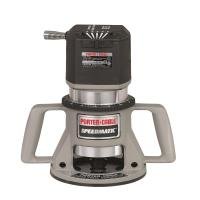One of the quintessential tools of any modern woodshop is a router. No matter what woodworking project you are working on, there is a good chance that it will call for at least one operation that utilizes a router. Whether you are applying a simple 1/2" round-over to a tabletop or making cathedral style raised-panel doors, having the right router for the right job is a must.
With so many routers available, sometimes it’s difficult to select the one that’s right for you. By reviewing a few key features, our hope is to provide the information needed to make your decision a little easier. We believe the selection process should be application based, so the first thing you’ll have to ask yourself is: what do I want to do with my router?
Speed Options:
 Router Classifications:
Router Classifications:
As with most tools, routers are available in several motor size configurations. All have certain advantages and limitations.
Palm Routers
Typically 1 HP or less, these routers offer a compact size with impressive performance. Palm routers are ideal for trimming, hinge mortising, edge forming, slot cutting, small-scale dovetailing, window cutouts and decorative inlays. Utilizes 1/4" shank bits. Due to the limitation of using only 1/4" shank router bits, these routers are not suitable for larger routing operations.

Mid-Size Routers
Ranging from 1-3/4 HP to 2-1/4 HP, these routers are the most popular size in the lineup due to their versatility and ease of operation. Mid-sized routers can handle a wide variety of operations, which include everything Palm Routers can do plus large-scale dovetailing, panel cutting, template design work and circle cutting. These routers will accept 1/4" shank as well as 1/2" shank bits and are often available with multiple bases (see Combination Kits below). It should be noted that the majority of aftermarket router accessories are geared to this class of router.

Full-Size Routers
These routers are the workhorses of the router family. Typically rated at 3 HP to 3-1/4 HP, these routers are designed for production use. These routers are often used dedicated to a router table or CNC operations. Due to the massive size of these routers, they can be somewhat cumbersome to use in everyday handheld operations.
Base Styles:
In many ways, the style of base that is selected is just as important as the size of motor that goes along with it. With several styles available, selecting the one that’s right for you will depend on the projects or operations you plan on undertaking.

Fixed Base
This is the standard base. These bases typically come with fixed handles or knobs on opposite sides of the base for holding and guiding the router. While these bases can be mounted to a router table, they are limited to edge routing applications. This style base is also ideal for operations that utilize guide bushings, like dovetail and box joint jigs. This style base often incorporates a quick setting ring-style depth adjustment.

Plunge Base
This style base is much more versatile in that it can be used for everything that a fixed base can be used for, plus operations that require the bit be plunged into the wood away from an edge. These bases are ideal for operations like blind grooves, fluting, dado cuts and mortising operations. The mechanics of this style base are that the motor will move up and down on machined spring loaded columns. A plunge base traditionally offers multiple depth stop settings with micro-adjustments that can be fine-tuned to your exact specifications.

D-Handle Base
Instead of two knobs, as on the standard base, there’s a knob and a D-shaped handle that provides pistol-grip control and a locking on/off trigger power switch

Special Note: If you anticipate the need for utilizing multiple bases, keep in mind that most manufacturers offer Combination Kits that incorporate a fixed base and a plunge base in one prepackaged kit. This is a great option because you are essentially getting two routers at a price that is much less than buying two separate routers.
As you are reviewing your options, one more thing to keep in mind is the compatibility of aftermarket accessories that are available for the router you are looking at. While most manufacturers will offer basic accessories like edge guides, router bushings, dust collection attachments and universal subbases, advanced accessories like router lifts, router plates and template guides are widely available but are brand/model specific.
One final warning – Due to the high degree of functionality, routers have been known to be addictive, so don’t be surprised if you end up with two or three routers.



